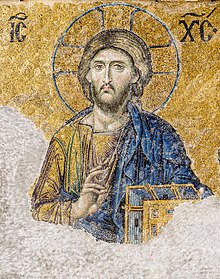Thaumaturgy
Thaumaturgy ( Greek θαυματουργός "miracle worker" - θαῦμα "miracle" and ἔργον "work") or miracle activity means as much as the ability to work miracles. Thaumaturg is the nickname of several Greek saints , for example Nicholas the miracle worker . In general, it also describes people who work miracles. The Thaumatologie is in theology, the doctrine of miracles .

Famous thaumaturges
Kings as thaumaturges
The French and English kings were revered as healers until well into modern times . In France the beginning of this belief is dated to the reign of Philip I , in England to Edward the Confessor . The king should be able to heal the scrofula by the laying on of hands. The term scrofula is derived from the Latin word scrofula , which means something like "swelling in the neck". From the Middle Ages to the early modern period, this term was used to describe inflammation of the lymph nodes and all other diseases of the neck that manifested themselves as inflammation and suppuration.
The healing of the scrofula is first attributed to Robert the Pious in the Epitoma Vitae Regis Rotberti Pii by Helgaud von Fleury . Since this work follows the hagiographic patterns of the time, it is not certain whether the royal miracle healings actually took place.
The writing De Pignoribus Sanctorum of Guibert, Abbot of Nogent-sous-Coucy , contains the following paragraph:
“Quid quod dominum nostrum Ludovicum regem consuetudinario uti videmus prodigio? Hos plane, qui scrophas circa jugulum, aut uspiam in corpore patiuntur, ad tactum eius, superadit crucis signo, vidi catervatim, me ei coherente et edam prohibente, concurrere. Quos tamen seine ingenita liberalitate, serena ad se manus obuncans, humillime consignabat. Cuius gloriam miraculi cum Philippus pater ejus alacriter exerceret, nescio quibus incidendbus culpis amisi. "
"What do I say? Have we not seen our lord, King Ludwig, perform the usual miracle? I have seen with my own eyes how sick people with scrofulae on their necks or other parts of the body poured in en masse to be touched by him and to receive the sign of the cross from him. I stood there very close to him and even tried to keep her away from him. The king, however, in his innate generosity, drew her to him with his illustrious hand and crossed her with great humility. His father Philip had also eagerly made use of this wonderful power, but he lost it through sins unknown to me, which he brought upon himself. "
The healing is thus a familiar ( consuetudinarius ) miracle that his father ( Philip I ) had already performed. This miracle has been expected at the latest since then, around 70 years after Robert the Pious, and the ability to do so is inherited.
In England the belief in royal healing powers arises at around the same time, but contemporaries like to relocate it back to the reign of Edward the Confessor . William of Malmesbury writes in his Gesta regum Anglorum that the belief that Edward's healing powers resided in his royal blood is an erroneous belief. This proves that this “mistaken belief” was widespread in Wilhelm's time.
The end of the practice of the healing cult and with it the end of this popular belief came in England with the rule of the House of Hanover (since 1714) and in France with the French Revolution .
literature
- Marc Bloch , Les rois thaumaturges (Eng. The miraculous kings ). Paris 1924 ISBN 3-406-47519-1 (German edition)
Essays on kings as thaumaturges:
- Werner Tietz: Rex humillimus. Holiness with Helgaud von Fleury in: Hagiographica; Journal of Hagiographie and Biographie of Società internazionale per lo studio del Medio Evo Latino; Volume IV, Florence (1997), pp. 113-132.
- Joachim Ehlers : The miraculous king in the monarchical theory of the early and high Middle Ages in: Heinig, P .; Jahns, S .; u. a. (ed.): Empire, regions and Europe in the Middle Ages and modern times. Festschrift for Peter Moraw; Berlin (2000), pp. 3-19.
The latest German-language book on this subject, which also deals with kings as thaumaturges in the first chapter:
- Franz-Reiner Erkens: The sacred rulers in the Middle Ages. From the beginning to the Investiture Controversy Stuttgart (2006).